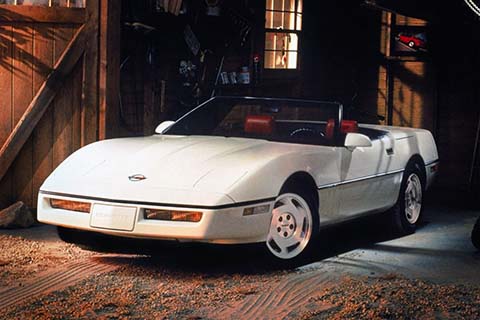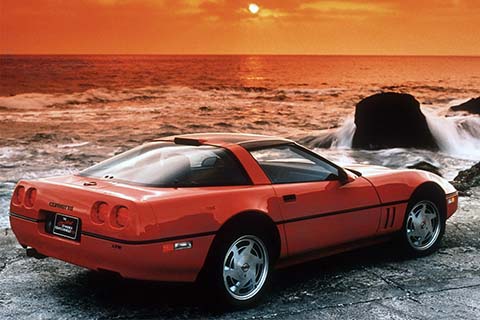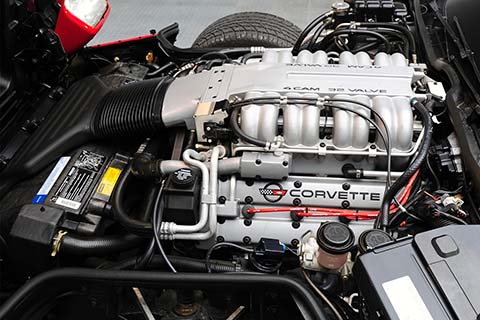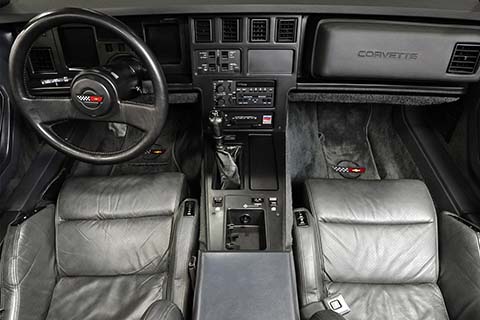The 1984-1996 Chevrolet Corvette C4 is a Classic Sports Car Steal
Overshadowed by its successor, this older 'Vette is still cheap retrowave fun
By Benjamin Hunting on June 27, 2022
There is no Rad ride more misunderstood than the C4-generation Chevrolet Corvette. The butt of a thousand jokes about gold chains, chest hair and mid-life crises, the 1984-1996 C4 has been lost in the sea of hyper-enthusiasm over the Japanese sports car renaissance of the late-'80s and early-'90s, with twin-turbos and trick all-wheel drive systems eclipsing the Corvette's comparatively low-tech appeal
It doesn't help that early on Chevrolet's hopeful halo underwent some awkward growing pains, requiring several years of refinement before being able to truly claim its status as a fun and fearsome performance machine. The subsequent appearance of the quantum-leap C5 towards the end of the '90s – which obliterated the C4 right out of the box in terms of performance while maintaining a moderate price point – served as a knock-out punch that further obscured the would-be icon's tarnished reputation among collectors and enthusiasts alike.
However, for those who aren't afraid to look beyond the conventional wisdom regarding this version of America's sports car, the C4 Corvette presents a unique opportunity. Far better to drive than foggy memory might suggest, cheap to buy and benefiting from a raft of modern upgrades and fixes for technologies that might not have originally been ready for prime time, Chevrolet's C4 stands today as a stealth steal among classic sports cars.

Tell me you wouldn't want this in your garage. | Chevrolet
Growing Into the Corvette Role
Make no mistake, when it first arrived as a 1984 model (skipping '83 due to production problems), the C4 was a legitimate high-performance machine…for its era. Being the fastest American car at a time when V8 engines struggled to surpass 150 horsepower (due to problematic emissions controls and crude electronic fuel injection systems) was the kind asterisk that dogged the Corvette throughout its early years.
Rated at a scant 205 ponies (which represented only five additional horsepower versus the C3 Corvette it replaced), the C4's lack of drivetrain fortitude somewhat obscured numerous advancements that positioned the platform as a formidable palette for future improvement. Notably, the transition to what GM labeled a “uniframe” structure (as opposed to the body-on-frame designs used in the past) contributed to the vehicle's reduced curb weight. The same was true of its move to fiberglass transverse leaf springs up front and plastic bumpers at each end.
Dropping pounds was crucial for Chevrolet at a time when power was at a premium, especially if the C4 was to crack 140 mph and at least keep the tail lights of rivals like the Porsche 930 Turbo in view. It also played an important role in the Corvette's fantastic handling. Out of the box, the C4 pulled 0.90 g on a skidpad, and that's at a time when tire technology was still fairly primitive. How good was the Corvette's cornering? Let's put it this way: The Sports Car Club of America was forced to kick the C4 out of its various racing series and create a single-marque Corvette Challenge.
Eventually, electronic engine controls caught up to the lusty expectations of Corvette buyers. By the following year the 230 hp L98 V8 arrived (bringing with it 330 lb-ft of torque), a figure that grew to 245 hp in 1990, but it was 1992's LT1 V8 that truly tapped into the potential of the standard Corvette's chassis, pushing output to 300 horsepower from its 5.7 liters.
By this point the Corvette also boasted a six-speed manual gearbox, having dropped its unusual 4+3 Doug Nash transmission (that tagged in a trio of electronic overdrive gears above its Borg-Warner guts) in 1989. An automatic was also available throughout the life of the Corvette, and is perhaps the most common gearbox as many buyers opted for the self-shifting four-speed. In fact, by the early '90s the auto unit had eclipsed the third pedal in popularity.

The 1990-1995 Corvette ZR-1 featured the LT5 V8 engine. | Chevrolet
Super Chevys: The ZR-1 and LT4 Engine
On top of the showroom stock editions of the C4 Corvette, there were also a pair of eye-popping variants that appeared towards the end of its run. The 1990-1995 Chevrolet Corvette ZR-1 made use of a Lotus-developed, Mercury Marine-built LT5 V8 that swapped pushrods for dual overhead camshafts on its way to producing between 375 and 405 horsepower (depending on model year). With a 0-60 mph time of under 5 seconds and a top speed approaching 180 mph, it was a true supercar killer.
Joining the hi-po frenzy was the Corvette's optional LT4 engine, which was available for the single model year of 1996. Most effectively deployed in the track-focused Grand Sport trim, it featured a high-revving 330 horsepower and 340 lb-ft of torque, and its rarity has made it highly sought after among C4 cognoscenti.

If you can get a C4 with the digital dashboard, do it. | Chevrolet
Laser-Blast Futurism and Electro-Pop Fantasy
Mechanical details aside, the C4's shape is another compelling reason to reconsider its place in your personal sports car pantheon. Breaking free from decades of tradition that had tied the look of the Corvette to the '60s-era Mako Shark concept, 1984's model was a laser blast of low-and-flat futurism. At the time, it resembled little else on the road, and today's slammed suspensions and lower profile tires have done wonders to visually invigorate even early C4 Corvettes by accentuating its broad visage and aerodynamic slipperiness. A convertible followed in '86, and in 1991 a “softer” look was applied across the entire C4 lineup, which included the introduction of square-ish tail lights to replace the previous portholes.
Then there's the interior. It's impossible to make apologies for the cabin material decisions made by GM in the '80s and '90s, where it seemed as though petrochemical composting by way of UV exposure was a top priority. The period-correct digital dashboard, however, is the stuff of electro-pop fantasy, allowing drivers to mainline data as though they were sitting on the bridge of the U.S.S. Enterprise. It lasted all the way until the 1990 model, when analog gauges reappeared.

Look at all the friends you could be making in a C4 Corvette. | Chevrolet
A Classic Sports Car Priced to Sell
Responsibly shopping for a C4 Chevrolet Corvette means navigating the minefield that separates the earliest cars from their better-built brethren.
The 1984 model's carry-over L83 engine was notorious for its Cross-Fire fuel injection system, which is difficult to properly tune and doesn't offer much overhead when it comes to generating more power. There are a ton of them out there, as sales of the reinvigorated Corvette were strong in its initial year, but unless you're planning on an engine swap, targeting the '85-and-up Tuned Port Injection engines is a safer bet. The 4+3 transmission was also notorious for having its electronic overdrive feature fail (taking out reverse gear at the same time). These two caveats have helped keep the pre-'89 Corvettes at surprisingly low prices (starting around $7,000), as they typically appeal to mechanically-minded buyers willing to get their hands greasy.
The best bang for your buck is found with LT1-powered cars, but even here the reliability of the Opti-Spark ignition system (whose mounting position at the front of the motor made it vulnerable to moisture) is a cause for concern. Fortunately, modern upgrades are available, and the rest of the LT1 design presents a formidable base for horsepower hop-ups (and is backed by the stout ZF six-speed gearbox). You can pick up a running and driving LT1 Corvette for around $10,000, with the nicest possible example rarely cresting $30,000.
If you've got more than a little loose change jingling in your pocket, consider too that the C4 Corvette ZR-1 is still somehow underpriced as compared to the twin-turbo Toyota Supras and rotary-powered Mazda RX-7s that capture more auction block glory. Hagerty lists the value of driver-quality ZR-1's in the low $20,000s, which is astounding given their performance and scarcity. Even the best of the best rarely crack the $60,000 mark.
Bargain basement pricing, sultry synthwave styling and a seemingly unlimited aftermarket combine with a truly engaging driving experience and a timeless V8 rumble to make the C4 Corvette the kind of classic sports car steal you won't want to sleep on much longer. Let the track rats soak up the more expensive C5s while you get in on the ground floor with a quick and fun coupe that won't break the bank – at least until the rest of the Radwood crowd takes notice.
